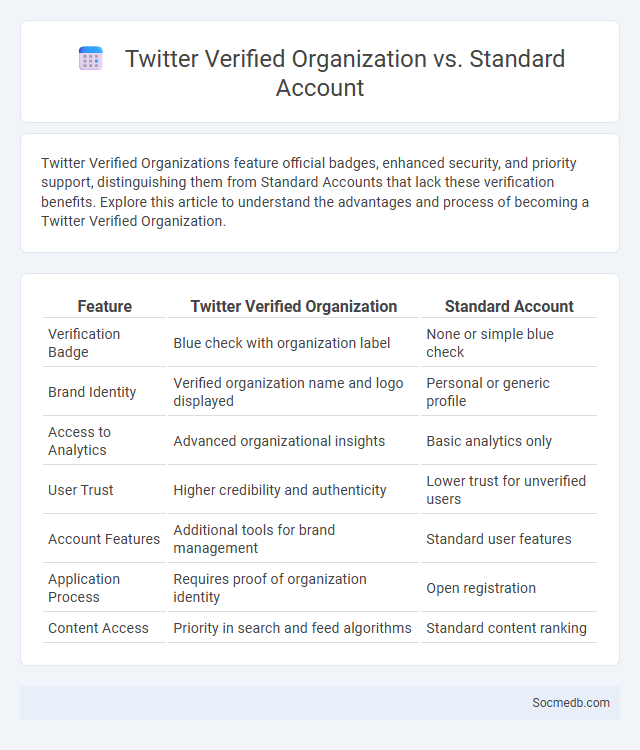
Photo illustration: Twitter Verified Organization vs Standard Account
Twitter Verified Organizations feature official badges, enhanced security, and priority support, distinguishing them from Standard Accounts that lack these verification benefits. Explore this article to understand the advantages and process of becoming a Twitter Verified Organization.
Table of Comparison
| Feature | Twitter Verified Organization | Standard Account |
|---|---|---|
| Verification Badge | Blue check with organization label | None or simple blue check |
| Brand Identity | Verified organization name and logo displayed | Personal or generic profile |
| Access to Analytics | Advanced organizational insights | Basic analytics only |
| User Trust | Higher credibility and authenticity | Lower trust for unverified users |
| Account Features | Additional tools for brand management | Standard user features |
| Application Process | Requires proof of organization identity | Open registration |
| Content Access | Priority in search and feed algorithms | Standard content ranking |
Overview of Twitter Account Types
Twitter offers various account types tailored to different user needs, including Personal, Business, Verified, and Twitter Blue subscriptions. Each account type provides unique features such as enhanced visibility, brand promotion tools, or exclusive content options designed to optimize engagement. Understanding the distinctions helps you choose the best account that aligns with your social media strategy and goals.
What is a Twitter Verified Organization?
A Twitter Verified Organization is an official status granted to businesses, brands, and nonprofits that have been authenticated by Twitter to ensure credibility and trustworthiness. This verification includes a blue checkmark badge displayed next to the organization's account name, signifying its legitimacy and helping users easily identify authentic sources. By obtaining this verification, your organization can enhance its visibility, improve audience engagement, and protect its identity from impersonators on the platform.
Defining a Standard Twitter Account
A standard Twitter account provides users with the ability to post tweets, follow other users, and engage by liking, retweeting, or replying to content. It is free to create, includes a profile with a display name, username, bio, profile picture, and header image, and supports up to 280 characters per tweet. The account also allows access to Twitter's timeline, trending topics, and direct messages, facilitating real-time interaction and information sharing.
Verified Organization vs Standard: Key Differences
Verified organizations on social media have a distinct blue checkmark symbol, signifying authenticity and credibility compared to standard accounts. Your verified status enhances trust, increases visibility in search results, and grants access to exclusive features like advanced analytics and priority support. Standard accounts lack these benefits, making verification crucial for brand reputation and audience engagement.
Features Exclusive to Verified Organizations
Verified organizations on social media gain access to exclusive features such as advanced analytics, priority customer support, and enhanced brand credibility through a verified badge. You can leverage tools like custom call-to-action buttons, access to specialized advertising options, and content moderation controls to optimize engagement and reach. These features collectively empower your organization to build trust, improve audience targeting, and maintain a professional online presence.
Benefits of Standard Twitter Accounts
Standard Twitter accounts offer significant benefits including free access to a global audience, enabling users and businesses to share information instantly and engage in real-time conversations. These accounts allow for content promotion through tweets, retweets, and hashtag usage, boosting visibility and follower growth without requiring paid advertising. Users also benefit from Twitter's analytics tools that provide insights on tweet performance and audience engagement, helping to refine content strategies effectively.
Verification Process for Organizations
The verification process for organizations on social media platforms involves submitting official documents such as business licenses, tax filings, or certificates of incorporation to confirm authenticity. Verified badges help establish trust and validate the organization's identity, reducing the risk of impersonation and increasing audience confidence. Platforms like Facebook, Instagram, and Twitter have specific guidelines and eligibility criteria that organizations must meet to qualify for verification.
Comparison Table: Verified Organization vs Standard Account
A verified organization on social media offers enhanced credibility, access to advanced analytics, and priority customer support compared to a standard account. Your verified status grants you improved visibility through verification badges and exclusive features like branded content tools and advertising options. Standard accounts lack these specialized benefits, limiting brand trust and engagement opportunities.
Use Cases for Each Account Type
Business accounts on social media enable advanced analytics, targeted advertising, and seamless e-commerce integration, driving brand visibility and customer engagement. Creator accounts focus on content monetization, audience growth tools, and collaboration features tailored for influencers and artists. Personal accounts prioritize social interaction, privacy controls, and content sharing, catering to individual users seeking connection and self-expression.
Choosing the Right Twitter Account for Your Needs
Selecting the right Twitter account depends on your specific goals, whether it's personal branding, business promotion, or community engagement. You should consider factors like audience demographics, content style, and frequency of updates to maximize your reach and interaction. Your ideal account aligns with your objectives and offers tools that enhance visibility and engagement effectively.
 socmedb.com
socmedb.com